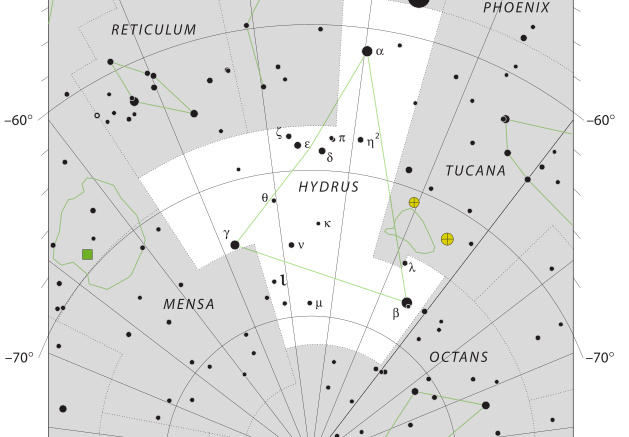Located in the Southern Sky, Hydrus is a small constellation created by Petrus Plancius from the observations of Pieter Dirkszoon Keyser and Frederick de Houtman. It first appeared on a 35-cm diameter celestial globe published in late 1597 in Amsterdam, and was depicted in the 1603 Uranometria atlas. The French explorer and astronomer Nicolas Louis de Lacaille charted the brighter stars and gave their Bayer designations in 1756.
Although its name is similar to Hydra, Hydrus means “male water snake.” Hydra is a much larger constellation that represents a female water snake. It remains below the horizon for most Northern Hemisphere observers, including observers in the Pacific Northwest.
| Applicable Information | |
| Visibility In Pacific Northwest | Not visible in Pacific Northwest |
| Best Times To View | Not visible in Pacific Northwest |
| Right Ascension | 00h 06.1m to 04h 35.1m |
| Declination | −57.85° to −82.06° |
| Area | 243 square degrees |
| Main Stars | 3 |
| Brightest Object | β Hyi |
| Meteor showers | 0 |
| Messier objects | 0 |
| Neighboring Constellations | Dorado, Eridanus, Horologium, Mensa, Octans, Phoenix, Reticulum, Tucana |
Interesting Facts
Hydrus covering 243 square degrees, which equates to 0.589% of the night sky; making the constellation the 61st largest constellation. The official constellation boundaries, as set by Belgian astronomer Eugène Delporte in 1930.
As a constellation located deep in the southern hemisphere, Hydrus remains below the horizon at latitudes north of the 30th parallel in the Northern Hemisphere. However, the constellation is circumpolar at latitudes south of the 50th parallel in the Southern Hemisphere.
Stars
There are 15 stars in the constellation. The brightest star is Beta Hydri, which is the closest reasonably bright star to the south celestial pole. VW Hydri is one of the brightest dwarf novae in the skies, can be found in the Hydrus constellation. Four star systems in Hydrus have been found to have exoplanets to date, including HD 10180, which could bear up to nine planetary companions.
The deep sky objects in the constellation are very faint. The White Rose Galaxy, known as PGC 6240 is a giant spiral galaxy surrounded by shells resembling rose petals. There is the spiral galaxy, NGC 1511, which lies edge on to observers on Earth and is readily viewed in amateur telescopes.
Hydrus does contain some objects from the Large Magellanic Cloud. The globular cluster NGC 1466 is an outlying component of the galaxy, and contains many variable stars. An emissions nebula, and some open clusters make up NGC 602, which is an outlying component on the eastern edge of the Small Magellanic Cloud.
Make sure to check out other articles on the site, including a brief introduction to constellations, other constellation articles, and more!

Be the first to comment on "Hydrus"